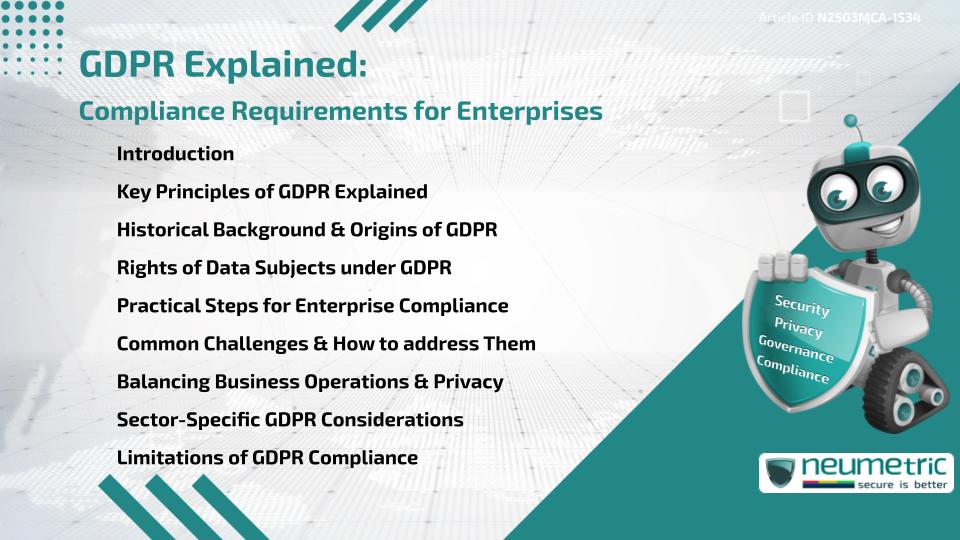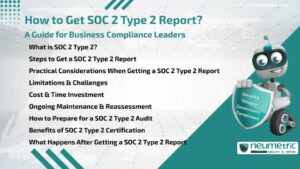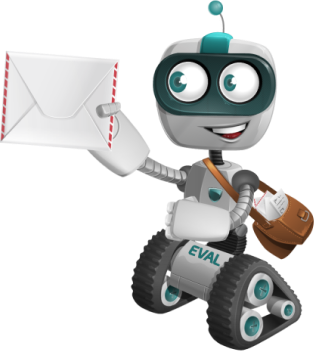Table of Contents
ToggleIntroduction
GDPR explained refers to understanding & applying the General Data Protection Regulation [GDPR], a legal Framework that sets guidelines for the collection & processing of Personal Data from individuals in the European Union. For enterprises, GDPR Compliance is not just a legal necessity but also a trust-building measure. This article explores the regulation’s principles, its historical background, the rights it grants, practical compliance steps, common challenges & its limitations.
Key Principles of GDPR Explained
The GDPR is based on principles that define how Personal Data should be handled. These include:
- Lawfulness, fairness & transparency: Processing must be clear & legitimate.
- Purpose limitation: Data should be collected for specified & lawful purposes.
- Data minimization: Only necessary data should be gathered.
- Accuracy: Data should be kept up to date.
- Storage limitation: Data should not be stored longer than needed.
- Integrity & confidentiality: Data must be protected from unauthorized access.
These principles form the foundation of GDPR explained & guide compliance measures.
Historical Background & Origins of GDPR
Before GDPR, the Data Protection Directive of 1995 served as the primary European Data Privacy law. However, rapid technological changes & globalized data flows made the directive outdated. GDPR came into force in May 2018, introducing stricter requirements & greater enforcement powers.
This shift reflects the growing recognition of Data Privacy as a fundamental right, shaping the modern understanding of GDPR explained.
Rights of Data Subjects under GDPR
One of the defining features of GDPR is its emphasis on individual rights. These include:
- Right to access: Individuals can request their data & understand how it is used.
- Right to rectification: They can correct inaccurate or incomplete data.
- Right to erasure: Also known as the “right to be forgotten.”
- Right to data portability: Individuals can request their data in a usable format.
- Right to object: They can object to certain types of data processing.
These rights are central to GDPR explained & require enterprises to adapt their systems & processes to comply.
Practical Steps for Enterprise Compliance
For Organisations, achieving compliance involves:
- Conducting data audits to identify & map all Personal Data.
- Appointing a Data Protection Officer [DPO] if required.
- Implementing Security Measures such as encryption & Access Controls.
- Updating Privacy Policies to reflect GDPR requirements.
- Training staff to handle Personal Data responsibly.
GDPR explained in operational terms is about embedding these practices into everyday business processes.
Common Challenges & How to address Them
Compliance can be challenging for enterprises due to:
- Complexity of data flows across borders.
- Managing Third Party processors.
- Keeping pace with evolving interpretations of GDPR requirements.
Overcoming these challenges often requires legal consultation, investment in Data Management tools & fostering a company culture of Privacy awareness.
Balancing Business Operations & Privacy
Some businesses fear that strict compliance will hinder efficiency or innovation. However, GDPR explained properly shows that protecting Personal Data can coexist with strong business performance. Like adding a seatbelt to a car, compliance adds safety without stopping the vehicle from moving forward.
Sector-Specific GDPR Considerations
Different industries face distinct Compliance Requirements. For example:
- Healthcare must comply with both GDPR & medical confidentiality rules.
- Finance faces GDPR alongside Financial regulations like the Payment Services Directive [PSD2].
- Education must safeguard Student Records under GDPR & national laws.
Understanding GDPR explained in a sector-specific context ensures compliance measures are relevant & effective.
Limitations of GDPR Compliance
While GDPR sets high standards, compliance alone does not guarantee complete security. Breaches can still occur if safeguards are not well-implemented. GDPR explained should therefore be seen as a baseline for Privacy protection, not a final endpoint.
Takeaways
- GDPR explained involves understanding the law’s principles, rights & obligations.
- Compliance requires operational, technical & cultural changes.
- Challenges include data flow complexity, Third Party Risks & resource demands.
- Sector-specific compliance needs careful consideration.
- GDPR Compliance is a foundation for Privacy protection, not an absolute guarantee.
FAQ
What does GDPR explained mean?
It refers to understanding the GDPR law, its requirements & how it applies to data processing.
Why is GDPR explained important for enterprises?
It ensures legal compliance, protects Customer Trust & avoids heavy fines.
Which rights are part of GDPR explained?
Rights include access, rectification, erasure, portability & objection.
How can an enterprise start with GDPR explained?
Begin with data audits, policy updates, staff training & appointing a DPO if needed.
Does GDPR explained apply to companies outside the EU?
Yes, if they process data of individuals in the EU.
Can GDPR explained prevent all data breaches?
No, it reduces Risks but cannot eliminate them entirely.
Need help?
Neumetric provides organisations the necessary help to achieve their Cybersecurity, Compliance, Governance, Privacy, Certifications & Pentesting goals.
Organisations & Businesses, specifically those which provide SaaS & AI Solutions, usually need a Cybersecurity Partner for meeting & maintaining the ongoing Security & Privacy needs & requirements of their Clients & Customers.
SOC 2, ISO 27001, ISO 42001, NIST, HIPAA, HECVAT, EU GDPR are some of the Frameworks that are served by Fusion – a centralised, automated, AI-enabled SaaS Solution created & managed by Neumetric.
Reach out to us!





